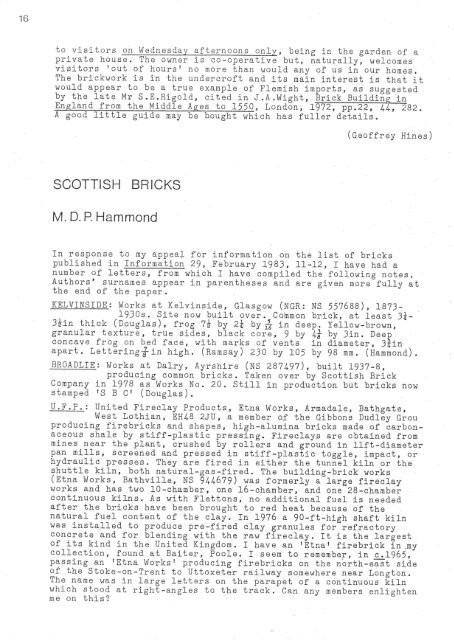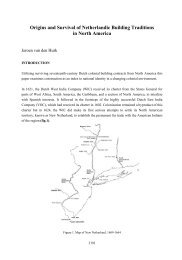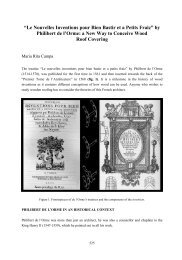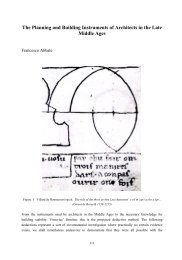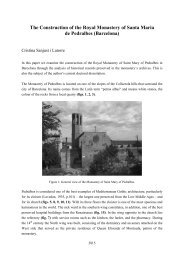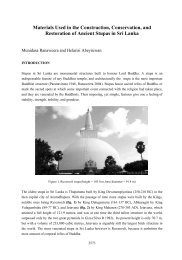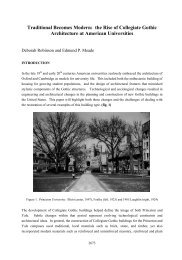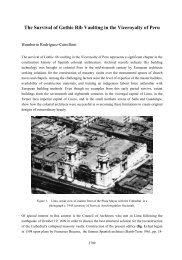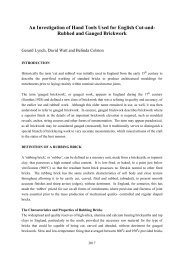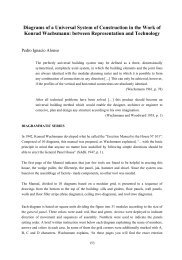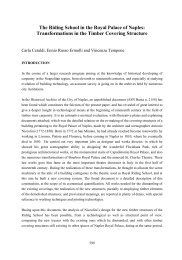bricks from the - Department of Architecture
bricks from the - Department of Architecture
bricks from the - Department of Architecture
You also want an ePaper? Increase the reach of your titles
YUMPU automatically turns print PDFs into web optimized ePapers that Google loves.
16<br />
to visitors o~ Wednesday afternoons only, being in <strong>the</strong> garden <strong>of</strong> a<br />
private house. The owner is co-operative but, naturally, welcomes<br />
visitors 'out <strong>of</strong> hours' no more than would any <strong>of</strong> US in our hornes.<br />
The brickwork is in <strong>the</strong> undercr<strong>of</strong>t and its main interest is that it<br />
would appearto be a true example <strong>of</strong> Flemish imports, as suggested<br />
by <strong>the</strong> late Mr S.E.Rigold, cited in J.A.Wight, Brick Building in<br />
England <strong>from</strong> <strong>the</strong> Middle Ages to 1550, London, 1972, pp.22, 44, 282.<br />
A good little guide may be bought which has fuller details.<br />
(Ge<strong>of</strong>frey<br />
Hines)<br />
SCOTTISH<br />
BRICKS<br />
M. D. P.Hammond<br />
In response to my appea+ for information on <strong>the</strong> list <strong>of</strong> <strong>bricks</strong><br />
published in Information 29, February 1983, 11-12, I have had a<br />
number <strong>of</strong> letters, £rom which I have compiled <strong>the</strong> following notes.<br />
Authors' surnames appear in paren<strong>the</strong>ses and are given more fully at<br />
<strong>the</strong> end <strong>of</strong> <strong>the</strong> paper.<br />
KELVINSIDE: Works at Kelvinside, Glasgow (NGR: NS 557688), 1873~<br />
1930s. Site now built over. Common brick, at least 3i-<br />
3iin thick (Douglas), frog 7i by 2t by A in deep ..Yellow-brown,<br />
granular texture, true sides, black core. 9 by 4i by 3in. Deep<br />
concave frog on bed face, with marks <strong>of</strong> vents ~n diameter, 31in<br />
apart. Letteringjin high. (Ramsay) 230 by 105 by 98 mm. (Hammond).<br />
BROADLIE: Works at Dalry. Ayrshire (NS 287497). built 1937-8.<br />
. producing common <strong>bricks</strong>. Taken over by Scottish Brick<br />
Company in 1978 as Works No. 20. Still in product.ion but <strong>bricks</strong> now<br />
stamped 's B C' (Douglas).<br />
U.F.P.: .United Fireclay Products, Etna Works. Armadale, Bathgate,<br />
West Lothian, EH48 2JU. a member <strong>of</strong> <strong>the</strong> Gibbons Dudlej Grou<br />
producing fire<strong>bricks</strong> and shapes. high-alumina<strong>bricks</strong> made <strong>of</strong>carbonaceous<br />
shale by stiff-plastic pressing. Fireclays are obtained <strong>from</strong><br />
mines near <strong>the</strong> ~lant. crushed by ~ollers and ground iri11ft-diameter<br />
pan mills. screened and pressed in stiff-plastic toggle. impact. or<br />
hydraulic presses. They. are fired in ei<strong>the</strong>r <strong>the</strong> tunnel kiln or <strong>the</strong><br />
shuttle kiln, both natural-gas-fired. The building-brick works .<br />
(Etna Works, Bathville. NS 944679) was formerIyalarge fireclay<br />
works and has two 10-chamber, one 16-chamber~ and one.28-chamber<br />
continuous kilns. As with Flettons, no additional fuel is needed<br />
after <strong>the</strong> <strong>bricks</strong> have been brought to red heat .because <strong>of</strong> <strong>the</strong> .<br />
natural fuel content <strong>of</strong><strong>the</strong> clay. In 1976 a 90-ft-high shaft kiln<br />
was insta,lled to produce pre-fired clay granules for refractory<br />
concrete and for blending with <strong>the</strong> raw fireclay. It is.<strong>the</strong> largest<br />
<strong>of</strong> its kind in <strong>the</strong> United Kingdom. I have an 'Etna' firebrick in ~y<br />
collection, found at Baiter, Poole. I seem to remember, in c.1965,<br />
passing an 'Etna Works' producing fire<strong>bricks</strong> on <strong>the</strong> north-east side<br />
<strong>of</strong> <strong>the</strong> Stoke-on-Trent to Uttoxeter railway somewhere near Longton.<br />
The name was in large letters on <strong>the</strong> parapet <strong>of</strong> acontinuous kiln<br />
which stood at right-angles to <strong>the</strong> track. Can any members enlighten<br />
me on this?


